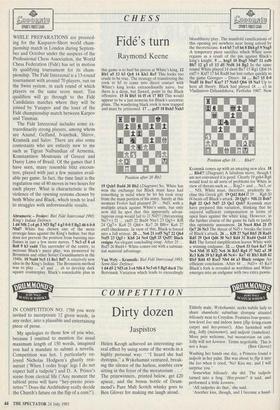.C.csoosilu CHESS
SPAIN'S FINEST CAVA ;ADDIAMIll SPAIN'S FINEST CAVA
Fide's turn
Raymond Keene
WHILE PREPARATIONS are proceed- ing for the Kasparov-Short world cham- pionship match in London during Septem- ber and October under the auspices of the Professional Chess Association, the World Chess Federation (Fide) has set in motion its qualifying tournament for its cham- pionship. The Fide Interzonal is a 13-round tournament with around 70 players, run on the Swiss system, in each round of which players on the same score meet. Ten qualifiers will go through to the Fide Candidates matches where they will be joined by Yusupov and the loser of the Fide championship match between Karpov and Timman.
The Fide Interzonal includes some ex- traordinarily strong players, among whom are Anand, Gelfand, Ivanchuk, Shirov, Kramnik and Salov. There are also some contestants who are entirely new to me such as Tigran Nalbandian of Armenia, Konstantinos Moutousis of Greece and Darcy Lima of Brazil. Of the games that I have seen, many resemble blitz encoun- ters, played with just a few minutes avail- able per game. In fact, the time limit is the regulation one of 40 moves in two hours for each player. What is characteristic is the violence of the opening systems chosen by both White and Black, which tends to lead, to struggles with unforeseeable results.
Abramovic — Frolov: Biel Fide Interzonal 1993; King's Indian Defence.
1 d4 Nf6 2 c4 g6 3 Nf3 Bg7 4 g3 0-0 5 Bg2 d6 6 0-0 Nbd7 White has chosen one of the more strategic lines against the King's Indian, but that does not prevent the position from bursting into flames in just a few more moves. 7 Nc3 e5 8 e4 Re8 9 h3 exd4 This surrender of the centre, to increase Black's piece play, was pioneered by Bronstein and other Soviet Grandmasters in the 1940s. 10 Nxd4 Nc5 11 Rel Bd7 A relatively new idea in the King's Indian. The Bronstein method was to play ... a5 and ... c6 to develop dark square counterplay. Black's remarkable plan in this game is to hurl his pieces at White's king. 12 Rb 1 a5 13 b3 Qc8 14 Kh2 Re5 This looks too crude to be true. The strategy of transferring the rook to h5 to come into direct contact with White's king looks extraordinarily naïve, but there is a deep, but flawed, point to the Black offensive. 15 f4 Rh5 16 f5 c6 17 Bf3 This would appear to be a just nemesis for Black's eccentric plans. The wandering black rook is now trapped and must be jettisoned. 17 ... gxf5 18 Bxh5 NxhS
Position after 20 Bb2
19 Qxh5 Bxd4 20 Bb2 (Diagram) So, White has won the exchange but Black must have had something in mind when he let his rook stray from the main portion of his army. Surely at this moment Frolov had planned 20 Nd3, with a multiple attack against White's units, but only now did he spot that this apparently advan- tageous coup would fail to 21 Nd5!! (threatening Ne7+) 21 ... cxd5 22 Bxd4 Nxel 23 Qg5+ Kf8 24 Qg7+ Ke8 25 QhS+ Ke7 26 Bf6+ Ke6 27 exd5 checkmate. In view of this, Black is forced into a full retreat. 20 ... Ne6 21 exf5 Ng7 22 Qh4 NxfS 23 Qg5+ Kh8 24 Ne4 Qg8 25 QxfS! Black resigns An elegant concluding coup. After 25 ... Bxf5 26 Bxd4+ White comes out with a substan- tial material advantage.
Van Wely — Kramnik: Biel Fide Interzonal 1993; Semi-Slav Defence. 1 d4 d5 2 N13 c6 3 c4 Nf6 4 Nc3 e6 5 Bg5 dxc4 The Botvinnik Variation which leads to exceedingly bloodthirsty play. The manifold ramifications of this opening are nowhere near being solved by the theoreticians. 6 e4 b5 7 e5 h6 8 Bh4 g5 9 NxgS A temporary piece sacrifice which White soon regains as a result of the pin against Black's king's knight. 9 ... hxg5 10 BxgS Nbd7 11 exf6 Bbl 12 g3 c5 13 d5 Nxf6 14 Bg2 In the same round White played 14 dxe6 Be7 15 Rgl Qb6 16 exf7 + Kxf7 17 h4 Rad8 but lost rather quickly in the game Georgiev — Dreev. 14 ... Be7 15 0-0 NxdS 16 Bxe7 Kxe7 17 NxbS Qb6 18 Na3 Up to here all theory. Black had played 18 ... c3 in Vladimirov-Dzhandzhava, Pavlodar 1987. Now
Position after 18 . . Rh4!?
Kramnik comes up with an amazing new idea. 18 Rh4!? (Diagram) A fabulous move, though I am not convinced it is good. Clearly 19 gxh4 Rg8 would lead to all sorts of problems for White in view of threats such as ... Rxg2+ and ... Ne3, or Nf4. White must, therefore, prudently de- cline this Greek gift. 19 Qd2 Rd4 If 19 ... Rg8 20 f4 beats off Black's attack. 20 Qg5+ Nf6 21 Bxb7 Rg8 22 Qe5 Nd7 23 Qe2 Qxb7 Kramnik may have prepared this variation, thinking that he enjoyed sufficient compensation in terms of open lines against the white king. However, in the further course of the game he fails to justify this optimistic assessment. 24 Nxc4 Rh4 25 f3 Qc7 26 Ne3 The threat of Nd5+ breaks the force of Black's attack. 26 ... Kf8 27 Ng4 Rh5 28 Radl Rd5 29 Qe4 Qd6 30 Ne3 Rd4 31 Rxd4 Qxd4 32 Rdl The forced simplification leaves White with a winning endgame. 32 ... Qxe4 33 fxe4 Ke7 34 Nc4 Nb8 35 Kf2 Nc6 36 Rd3 Rg4 37 Nd2 a5 38 Rc3 Kd6 39 h3 Rg8 40 Nc4+ Ke7 41 Rb3 Rd8 42 Rb5 Rd4 43 RxcS Nb4 44 a3 Black resigns An efficient conclusion. After 44 ... Nd3+ 45 Ke3 Black's fork is revealed as worthless and White emerges into an endgame with two extra pawns.


















































 Previous page
Previous page